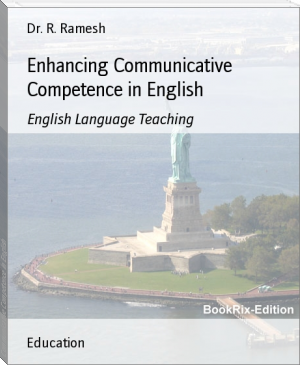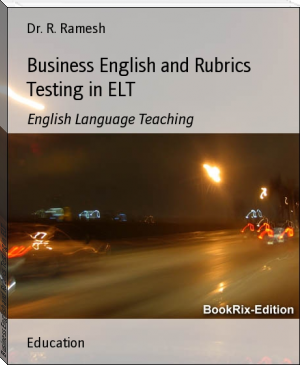Cognitive Development in English Language Teaching, Rajesh Lane [best motivational books for students txt] 📗

- Author: Rajesh Lane
Book online «Cognitive Development in English Language Teaching, Rajesh Lane [best motivational books for students txt] 📗». Author Rajesh Lane
Emotive and referential meanings are defined by Eugene A. Nida in his book ‘Toward A Science of Translation’ as: “Referential meanings refer primarily to the cultural context identified in the utterance (though of as dictionary meaning), while emotive meanings relate to the responses of the participants in the communicative act (feeling)” (Toward A Science of Translation.70)
At the U.G level the learners are not allowed to express their views or the emotive meaning of their feelings freely. The chance should be given to the learners to meet their emotions to improve their creativity. This would encourage learner to produce unlimited contexts. The acquired system and emotion will produce several messages for various contexts. Specifically the learner should be allowed to speak.
Joan Rubin says, “The students who had no experience in learning a language were easily frustrated and ended up scoring the lowest” (Language Teaching Language use language Teaching and the curriculum, 272)
Successful language learners are very effective in using their acquired knowledge to build a new system of communication. When the learning situation does not support learner’s knowledge they would be frustrated and bored. While acquiring the new material or the subject, learners strive to understand. Learner’s misunderstanding of the subject can be avoided with the use of suitable techniques. To facilitate and develop learner’s cognition, cognitive and metacognitive strategies can be used. Metacogntion is the knowledge or awareness of learner of the subject before getting a proper cognition or acquisition. It is the knowledge that helps cognition. Cognition is a process where learners come to understand the subject clearly by comparing with metacognition of the knowledge.
The cognitive and metacognitive strategies can be explained through the
following figure:-
Cognitive and metacognitive strategies are defined by experts as follows:
Cognitive strategies are behaviors techniques, or actions used by learners in a particular learning situation to facilitate acquisition of knowledge or skill. Meta cognitive strategies include learners awareness and knowledge of their own learning processes, as well as their abilities and tendencies to control these processes during learning. (Language Teaching Language use language Teaching and the curriculum, 274)
The aforesaid two quotations indicate that the cognitive and meta cognitive strategies can by used in developing learning condition. According to the researcher’s point of view, the same cognitive and metacognitive strategies can be applied in the process of second language acquisition also.
Meta cognitive and cognitive strategies allow the learner be a problem –solver and to expand their knowledge. Learners have to collect the knowledge through internet browsing; newspapers, articles, books and from other sources. When meta cognition is activated the learner gains cognition. Learner’s guessing acts as a major role in metacognition. Learners may differ in their metacognition. During classroom acquisition learner regulates his metacognition.
In the classroom some learners may perform well, and not well. The learner who performs classroom activities with less cognition should not be treated as a problem. The learner acquires less cognition, which indicates that s/he does not get enough metacognition. Some learners are more intuitive others more analytic. Here the teacher can facilitate their cognition by identifying their strength and weaknesses. Sometimes the metacognition maybe confused with cognition in their sense of understanding. To avoid learner’s sense of difficulty in understanding, the cognitive grading principle can be used.
According to the cognitive Grading principle:
One of the justifications for the principle that each new items should confirm what has been taught and should prepare the learners for what is to come, is the prevention of what the psychologists call retroactive-inhibition, where new material is confused with old materials in such a way that neither can be remembered. The term retroactive inhibition basically refers to the effect of later learning on earlier learning. (“Materials for the Teaching of English, Block –I”, 20)
By contrast, proactive interference or inhibition is the interfering effect of earlier learning on later learning. “In good gradation, the new material would strengthen the known material by the process of facilitation” (“Materials for the Development of Language skills, Block –I”, 20).
Teacher can facilitate learner’s cognitive process of acquisition and creativity by learner–led classroom activities. In the learner-led class the learner is allowed to do the classroom activities. There each learner can act as a teacher. Learners are divided into groups. Through the peer-group activities such as discussion, Role-play, simulation and other cognition improving activities the learner acquires and expresses his entire ability. The teacher-led classroom activities may be needed to help the students in their difficulty. When the socio cultural economic situations which s/he knows are brought into the classroom, learners can interact easily with the help of his/her metacognition. However ,when the learner comes to encounter new or the emergent contexts, s/he tries to solve or create the utterances with his/her own emotion which are totally new. In this context learner’s cognition plays as a problem solver. Consequently his/her acquisition and creativity improves.
Learner has to produce effective utterances in accordance with emergent syllabus along with emergent themes. Emergent syllabus means. Something that is interesting to the learners which is totally new and that which focuses on classroom discussion. Cognitive development is the only competent process to improve the learner’s effective communication creatively. It is possible that the learner can enhance his/her second language acquisition and creative abilities through contextualization of classroom activities.
This project recommends to break all the barriers of fixed notions on learners and their acquisition of language cognitively.
Researcher’s hypothesis intends that the classroom proceedings should be on the basis of the student’s needs. The age, psychological, socio-economic-cultural factors are to be taken into consideration before the syllabus is framed. Emergent syllabus and emergent themes can help the learners to produce any number of new utterances according to the context.
CHAPTER TWO
ROLE OF EMERGENT SYLLABUS
Emergent syllabus is a competent syllabus to exalt the creativity of the learners. The emergent syllabus is based on the contextualization of the language. The process of contextualization of subject is vital in second language acquisition. To create an appropriate context, to develop understanding and to encourage the creativity of the learners, the emergent syllabus would be helpful. The emergent syllabus has the capacity to improve the cognition of the potential knowledge of the learners to solve various problems and to create a new situation for practicing effective communication. The second language learner has to use the language according to the socio cultural context. So the learner must be capable of adapting his/her speech acts to match the specific socio cultural context. Context – based language acquisition may help the learner to avoid misunderstanding. Emergent Syllabus is task – based and learner centred to meet out the requirements of the learners.
Syllabus may be defined as: “ Syllabus refers to the content or subject matter of an individual subject “(The ELT Curriculum, 4). In a broader sense, besides the textbook, the only guide or blue – print the teacher gets is the syllabus. It is seen as a document, which, on the basis of the information, gives guidance on the details of the transmission of knowledge. These details pertain to the selection, clarification, distribution, transmission and evaluation of knowledge. “ The syllabus contains what, according to experts (and society) is considered to be valid knowledge and valid transmission of knowledge. An Emergent Syllabus is defined as “ One which develops with decisions made at the moment of teaching – learning. “Materials for the Teaching of English, Block-II,” 35)
Emergent Syllabus is not product – oriented but process – oriented syllabus. According to N.S.Prabhu, “ The process syllabus focuses on what is to be done in the classroom as opposed to what is to be taught (“Materials for teaching of English, Block-II”, 35).
Breen adds on the subject as : “ The classroom is therefore the meeting place or point of interaction between the predesigned syllabus and the individual learner syllabus. This interaction will generate the real – syllabus or the syllabus in action – which is jointly constructed by teachers and learners together” (“Materials for Teaching of English, Block – II”, 33)
Emergent Syllabus is the actual syllabus opposed to the ideal syllabus. Ideal syllabus is based on what ought to happen in the classroom. Actual syllabus basically involves implementation or actual classroom activity.
Emergent syllabus depends on the decisions of the moment made by the teacher and student together. Emergent syllabus considers learner’s needs. After the joint decision making, the classroom syllabus is framed.
Diagrammatically the distinction made by Breen can be seen as follows:
The Syllabus [ syllabus . A ]





Comments (0)